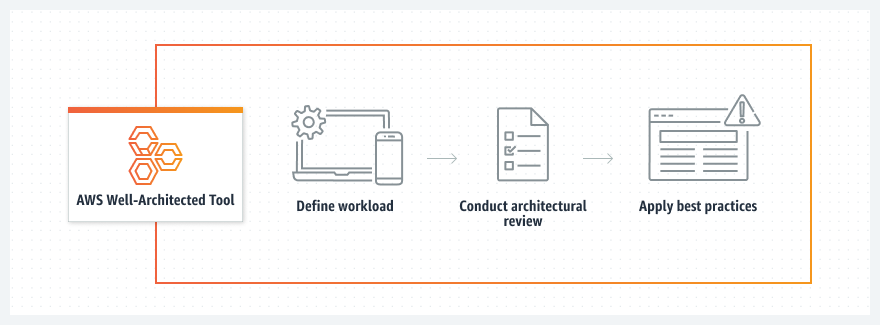
Each year, Amazon Web Services releases hundreds and thousands of updates and new features, so how can you ensure your workload is making the most of it and that you're prepared for the future?
The simple answer is Well-Architected Review (WAR).
The AWS Well Architected Review (WAR) provides your organization with a framework that helps cloud architects understand the pros and cons of making decisions while building secure, high-performing, resilient, and efficient systems on AWS.
It does this by reviewing an existing AWS workload against the five pillars of the WAR framework:
Five Pillars of WAR Framework
1. Operational Excellence
Ensuring that workloads are developed and operated in an optimized manner, offering insight into workload operations while enhancing supporting processes and procedures necessary to improve business performance.
Best Practices for Operational Excellence
- Perform operations as code - remember, don’t perform operations manually. Instead, you can use tools like cloud formation to build your infrastructure automatically.
- Make frequent, small, reversible changes - rather than significant changes that are difficult to roll back, making frequent small changes helps you if something goes wrong, and you can also quickly roll back and try again.
- Redefine operations procedures frequently - with constant re-evaluation, you can anticipate failure and prevent it before it occurs and make sure that you can recover from failure when it happens.
2. Security
Helping deliver business value through mitigation strategies and risk assessments to protect information systems, data, and assets.
Best Practices for Security
- Implement a strong identity foundation - ensure that your identity management systems are well-secured and that users get access to what they need.
- Enable traceability - this allows you to find out what's going on and where problems arise.
- Apply security at all layers - remember, don’t just apply for protection at the perimeter. Make sure that every layer of your application and infrastructure has security applied.
- Automate security best practices - automation reduces human error.
- Protect data in transit and at rest (when it’s stored in a storage system or database).
- Keep people away from data - secure your data access by implementing the proper access controls.
- Prepare for security events - it is essential to be prepared for malicious attacks, such as distributed denial of service attacks.
3. Reliability
Ensuring that a workload can effectively perform its intended function despite failures in infrastructure or services during the entire lifecycle of the workload.
Best Practices for Reliability
- Automatically recover from failures - if any of your systems fail, try to recover automatically without any manual involvement.
- For example, let’s take amazon ec2 auto-scaling. If a system fails or an instance fails, it will be automatically replaced by auto-scaling, and your load balancer will start distributing traffic to it. That’s called automatic recovery.
- Test recovery procedures.
- Scale horizontally to increase aggregate workload availability.
- Stop guessing capacity.
- Manage change in automation.
4. Performance Efficiency
Utilizing computing resources efficiently to meet system requirements and remaining efficient as demand changes and technologies advance.
Best Practices for Performance Efficiency
- Democratize advanced technologies - this delivers value to your business.
- Go global in minutes - deploy your application globally quickly.
- Use serverless architectures.
- Experiment more often - this improves your processes and performance.
- Consider mechanical sympathy - understanding the system and its purpose will help you utilize it to its full potential.
5. Cost-optimization
Allowing systems to deliver business value at the lowest possible cost.
Best Practices for Cost-optimization
- Implement cloud financial management.
- Adopt a consumption model in AWS.
- Measure overall efficiency.
- Avoid spending money on undifferentiated heavy lifting.
- Analyze and attribute expenditure.
So, that’s about the five pillars of the AWS WAR Framework that allow your cloud architects to take a lifecycle approach to manage your AWS workload.

Other Benefits of AWS WAR:
- Applying the right AWS Design principles can improve workloads on AWS over time. With this tool, you get an understanding and recommendations on how to apply the AWS Design principles.
- You can envision and plan a future state workload with the highest security and reliability level, optimized for performance and at a predictable cost.
- Understand the impact of design decisions and make the right decisions about your architectures in a cloud-native manner.
- AWS provides significant funding in the form of usage credits for every submitted and approved AWS workload; you can utilize other AWS-sponsored funding programs.
- Every time you perform a WAR, you get the opportunity to make your applications even better through cloud services. The recommendations from a reviewed workload often result in a more reliable, secure, and resilient workload running at a lower cost. And they allow you to increase your AWS workload over time.
Bottom Line
As noted above, it is clear, the Well Architected Review (WAR) validates that the best practices are in place and that the workload is cost-effective.
At the same time, a WAR provides recommendations and potential improvements to your AWS workload and prepares cloud architects to use new AWS services and technologies over time.
You may conduct a Well-Architected Review on your own with the Well-Architected Tool, or you could work with an advanced tier partner, like Global Technology Solutions (GTS), for a custom assessment. As an approved partner, GTS, may also be in a position to help you offset the cost of a Well-Architected Review through the AWS partner funding program.
Get in touch with us today to learn more.